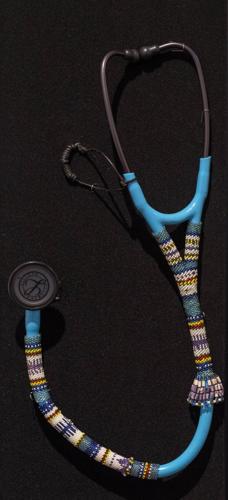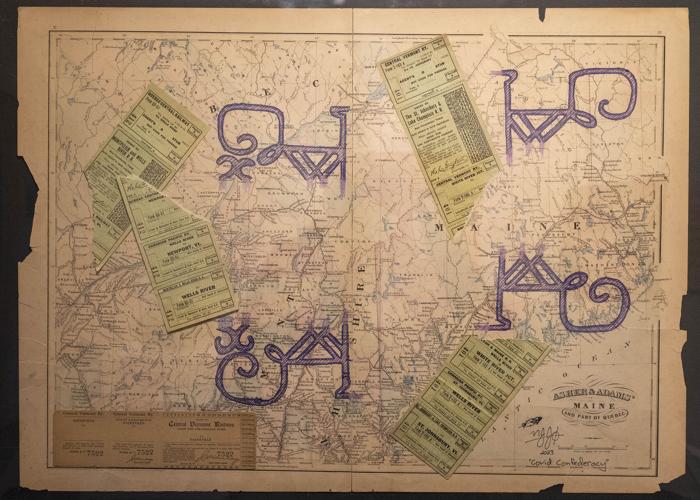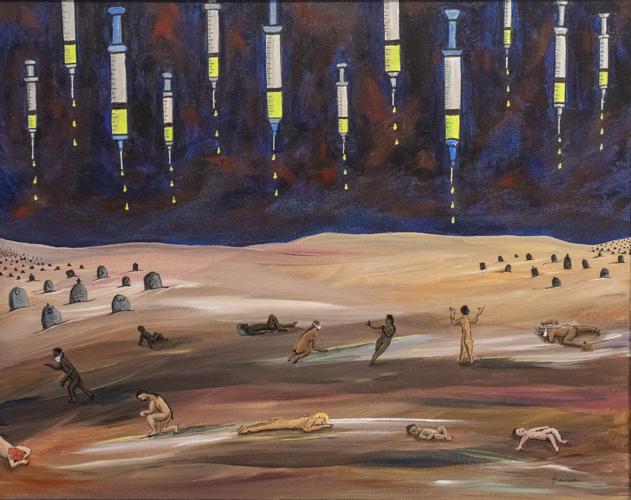Arms intertwine tenderly as a woman embraces another in the engraved ink drawing on one side of a hollowed gourd in Jeanne Morningstar Kent’s “Gagalwanogan — A Hug.” On the other side, two little girls in knee-length dresses walk, holding hands. The taller girl leads the way as the ponytailed sister follows.
Accompanying the gourd is a short text by Kent, explaining that the piece was inspired by the last communication she had with her sister, as the world was locking down with the spreading COVID-19 pandemic.
On May 1, 2020, Kent had a final phone call from her ailing sister in Maine. A few hours later, alone in her home, Kent felt a tight embrace, and knew that her sister had passed.
Kent, an enrolled citizen of the Nulhegan Band of the Coosuk Abenaki Nation, shares more about her sister and the symbolism in the piece in her text.
“A Hug” and Kent’s story are among the artworks and narratives by Abenaki artists and community members featured in “Beyond the Curve: American Abenaki COVID Experience,” up through Jan. 6, at the Mad River Valley Arts Gallery in Waitsfield. The exhibition is a project of the Vermont Abenaki Artists Association (VAAA) and is curated by Vera Longtoe Sheehan, its director. She is an enrolled citizen of the Elnu Abenaki Tribe.
Artwork and stories in “Beyond the Curve” share personal experiences and perceptions of members of the Vermont Native American community during these recent pandemic years. It brings together works in many media by professional Abenaki and other Native American artists of this region, and narratives, images, and creative pieces gathered in the 2022-23 Abenaki Storytelling Project.
Through the Storytelling Project, the VAAA met with people in the Indigenous community at events including the Abenaki Heritage Weekend. With writing prompts, art supplies and openness, the project offered opportunities for reflection and healing.
“It was very important for us to have this point in our history recorded by our own community instead of by an outsider. We are not always involved in representations of ourselves,” said Sheehan.
“Beyond the Curve,” whose title refers to the call to “flatten the curve” of incidence of illness from the COVID-19 virus, presents a broad picture of the pandemic experience in this region’s Native American communities. Isolation, disruption of connections, grieving, loss, and the legacy of historic trauma are among the themes explored.
The VAAA curatorial statement notes that with the pandemic, “Here in N’Dakinna (our homeland) Abenaki families turned to traditional medicines and other cultural practices for comfort and survival, connecting with nature and small family groups.”
A corner of the gallery focuses on traditional healing. It includes a drum made by Bernie Mortz, late war chief of the Nulhegan tribe, and a beaded bag honoring the late healer Doris Minckler. A stethoscope, bridging Western and traditional medicine, is adorned with extensive glass beading by its owner, Aaron York, a trained EMT.
“Native American health care workers embellish their stethoscopes with beadwork as a message to clients that their cultural needs will be met,” explained Sheehan at the gallery.
Prayers for healing are in the design of handwrought silver pieces by Paul René Tamburro, “Turtle Island Bounty” — Turtle Island is North America. Tamburro explains in his narrative that double curves are symbols for fiddlehead ferns representing new life and hope, the bear “Awasos” taught Indigenous people medicinal plants.
Traditional basketmaking, woodworking and ceramics are beautifully represented including with split ash baskets and carved wooden bowls by Bill Gould, traditional style stoneware by Vicki Blanchard, and a stunning ash bark pack basket by Jennifer Lee.
Julia Marden, a member of the Aquinnah Wampanoag tribe, lives in Vermont. Her two striking beaded masks reference pandemic era protective gear. “Keep Away,” in the surgical mask style, shields the lower face with tightly woven red-and-white beads — the triangular patterns of white beads have the look of sharp teeth.
“Architects of Genocide,” from Marden’s Wampum Story Belt Series, features three powerful panels in black-and-white glass beads — “Doctrine of Discovery” on colonization, “Indian Removal Act” on the forced march of the Cherokee people; and “Kill the Indian Save the Man” on forced separation of Native American children from their families.
Nathan Johnson’s “Covid Confederacy” and “Alnombak” draw on the 19th-century Native American practice of ledger art when pages from accounting books were used for drawing and painting. For “Covid Confederacy” Johnson uses an antique map of Maine, Vermont, New Hampshire and Quebec. Old train tickets are collaged on it and Abenaki symbols drawn in purple.
“Covid Confederacy,” Johnson explains in his statement, speaks to historical travels and the fracturing of community during the pandemic.
In “C” by Francine Poitras Jones, hypodermic needles float in a dark sky, neon yellow drops dripping to a parched earth. Beneath them are people of different skin colors and ages — some collapsed on the ground, some running away, one has arms raised. Gravestones with diverse religious symbols are in the background.
The painting, Jones explains in her attached narrative, “was created as my response to the COVID-19 pandemic which was an incredibly dark time for the entire planet. It seemed that no one was exempt from the pain and suffering, loss of loved ones, separation, extreme vulnerability ….”
Mad River Valley Arts Mad River Valley Arts presents “Beyond the Curve,” art reflecting the Abenaki COVID experience, through Jan. 6, at 5031 Main St. in Waitsfield. Hours are 1 to 5 p.m. Tuesday-Saturday; call 802-496-6682 or go online to www.madrivervalleyarts.org







